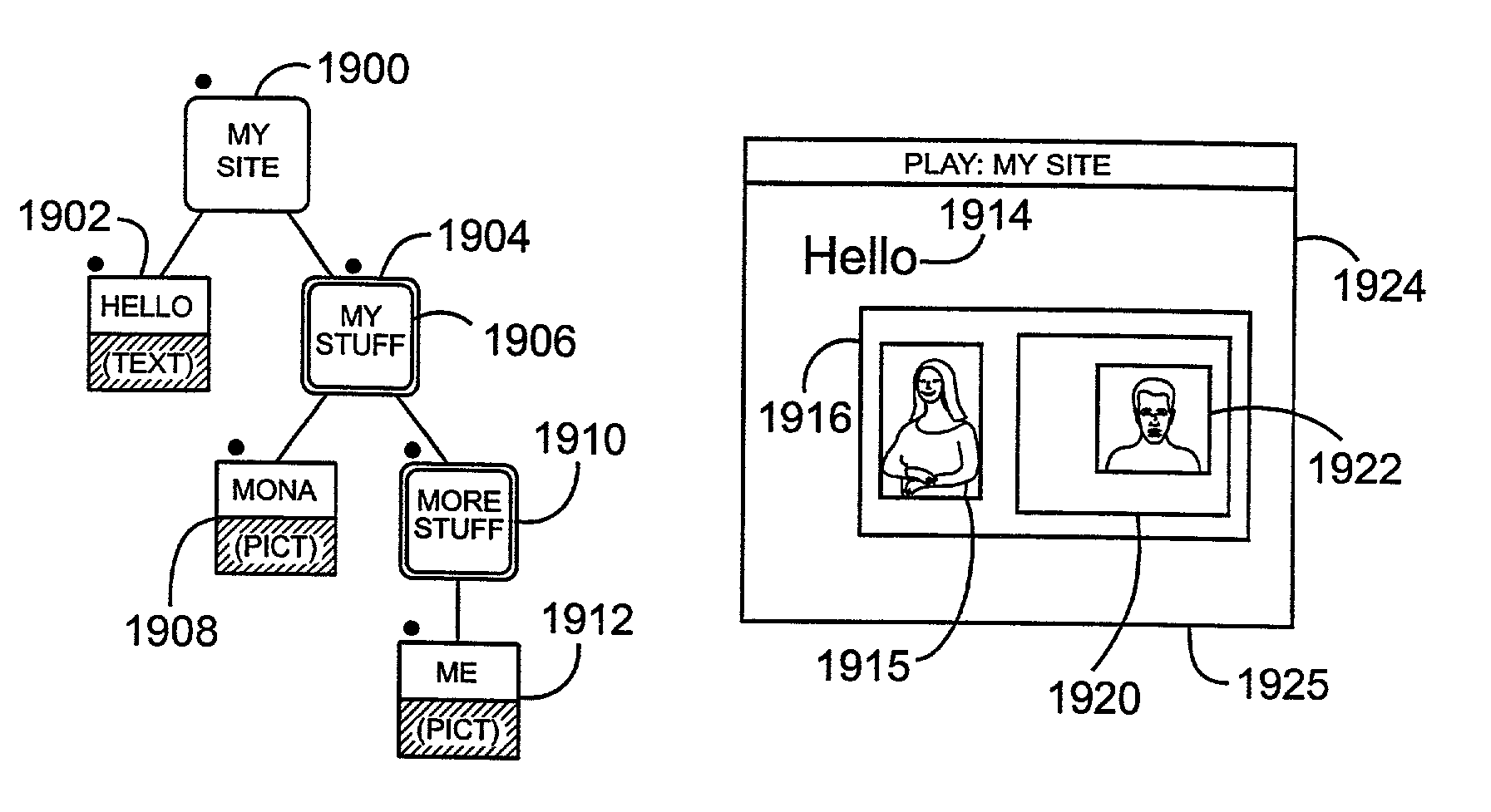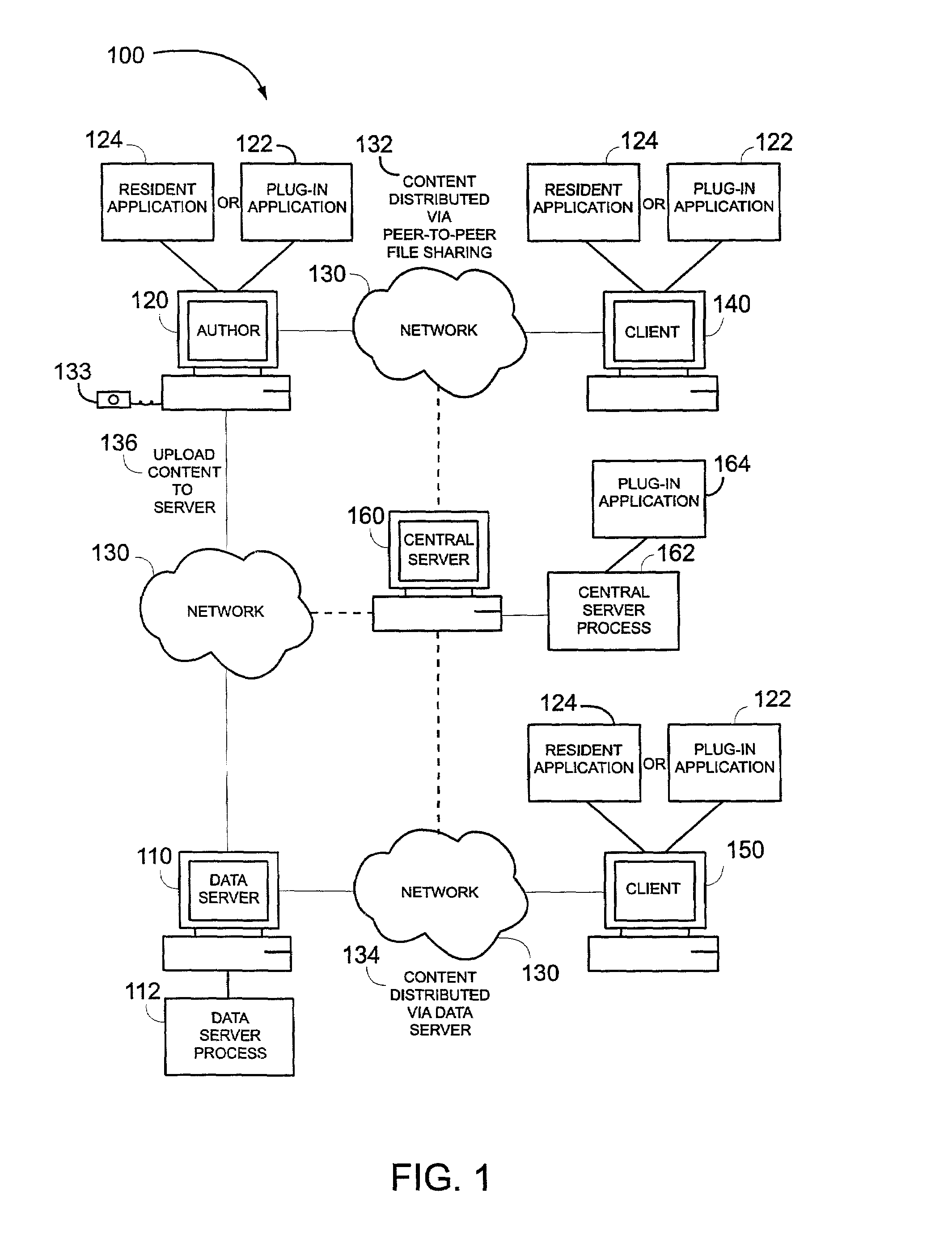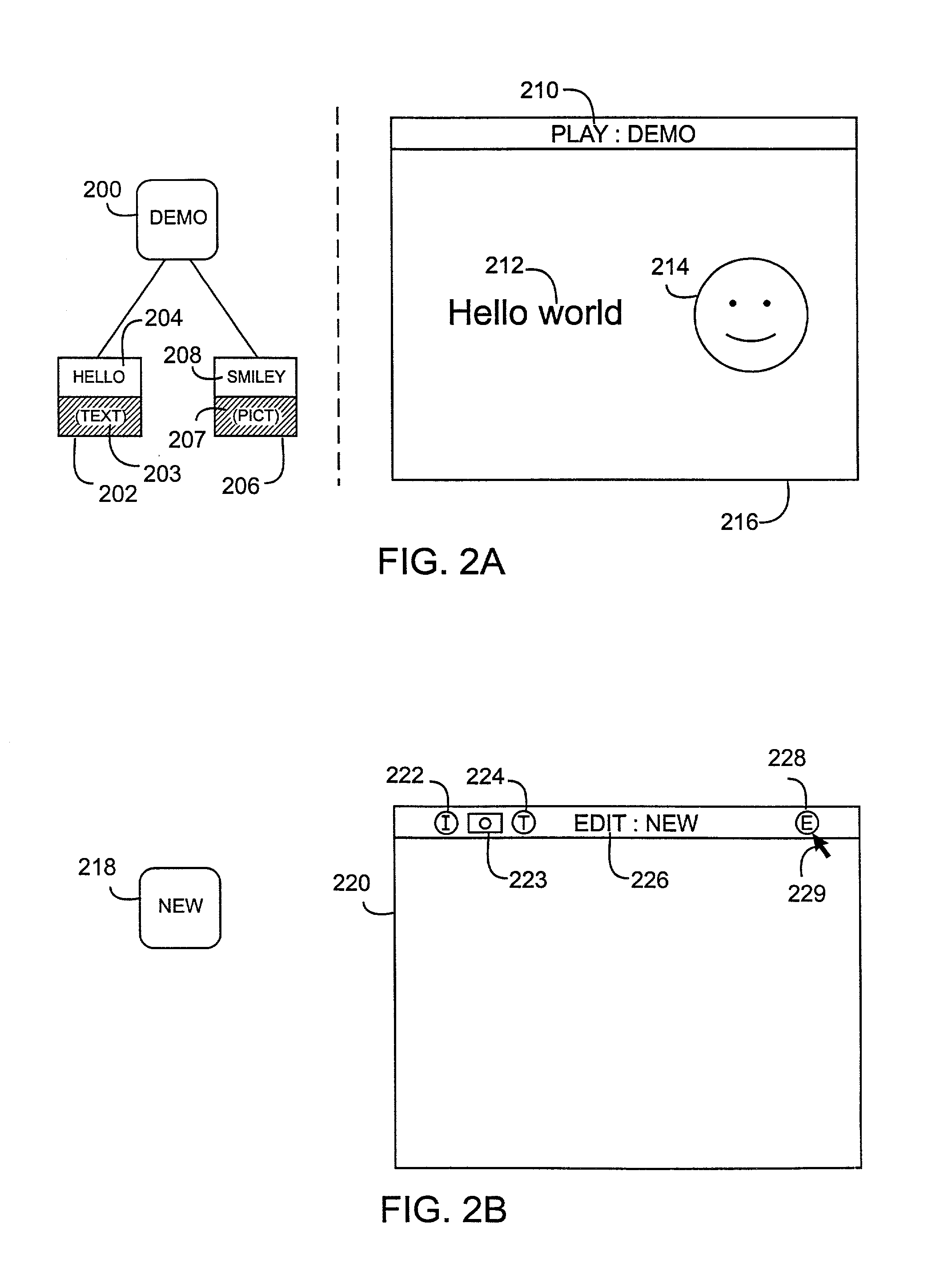Furthermore, the evolution of these tools has failed to keep pace with the growing
mass market of
computer users.
In particular, many of the authoring tools were initially designed for professional use, and attempts to “dumb them down” for non-professional users have lead to mixed results.
However, current methods of scripting are often unsatisfactory due to the procedural nature of scripting.
Especially when dealing with highly interactive multimedia presentations with numerous possible states and paths, the step-by-step nature of the script instructions tends to obscure the true structure of the content, and requires substantial mental
visualization, i.e. sophistication on the part of the author, to be used effectively.
As a method for controlling the behavior of media objects in a
multimedia system where ease of use for unsophisticated users is needed, current methods of procedural scripting have significant drawbacks.
One drawback is that the procedures used to create the scripts are abstract and fragmented, and do not correspond either directly or intuitively to the shape and structure of the resulting multimedia presentation.
This problem becomes worse as the size and complexity of the multimedia presentation increases.
To create a set of scripts that represents a highly interactive or
expansive presentation, a large number of non-intuitive, interrelated procedures must be performed, often presenting a complex or frustrating burden to authors, particularly those who are inexperienced.
Another drawback is that current methods of scripting frequently result in rigid or too simplistic algorithms for determining the activity in a presentation.
This tendency often leads to mechanical-looking results and misses the objective of creating appealing and entertaining multimedia content.
For systems that otherwise derive
advantage from creating multimedia content that is attractive or interesting to a viewing audience, this presents a burden in delivering appropriate results.
Therefore, current systems and methods which use scripting to enable the author to specify the playback behavior of media objects are generally unable to provide the
clarity, intuitiveness, and ease of use required to efficiently and effectively produce multimedia, websites, and other audio-visual content.
However, current methods that use templates are frequently unsatisfactory due to the pre-programmed nature of the template, and because the author generally has no input into the form of the template or the functionality it provides.
Particularly with regard to multimedia presentations where individuality or uniqueness is desirable, an author's creative intentions are frequently unable to be realized using templates.
As a method for controlling the behavior of media objects in a
multimedia system where detailed or flexible control is needed, current methods using templates have significant drawbacks.
One drawback with current methods using templates is that the procedures undertaken to develop templates cannot take into account each individual author's profile, likes and / or dislikes, but must rather make broad assumptions about authors in general.
For templates to be effective in assisting authors to realize their creative intentions, this presents a burden in the provision of effective assistance.
Another drawback is that current methods using templates typically result in media object behavior that is generic, inflexible or overly simplistic.
This tendency often leads to multimedia content which is “canned” looking or otherwise uninteresting.
For systems that derive
advantage from creating multimedia content that has such characteristics as uniqueness or interest for the viewing audience, this presents a burden in delivering appropriate results.
Therefore, current systems and methods using templates to enable the author to specify the playback behavior of media objects are generally unable to provide the usefulness, flexibility, and author-specific objectives required to efficiently and effectively enable satisfactory authoring of multimedia, websites, and other audio-visual content.
In these cases, the timeline approach has significant drawbacks.
Defining behavior on a frame-by-frame basis is an inherently painstaking process, not conducive to quick gestures or spur-of-the-moment ideas.
When interactivity is required the situation gets even more complex.
But interactive presentations are inherently non-linear, since they must account for circumstances and user choices that will happen at unpredictable times. Therefore, in order to program even the most basic levels of interactivity, professional tools like Flash 5 must employ scripting, which has drawbacks that have already been discussed.
But timeline templates present similar problems to the templates already discussed.
They are inflexible, limit the creative input of the user and often result in a canned look.
Consequently, the method used by Web browsers to effect page changes is conceptually simplistic, involving first discarding the current page and then loading and displaying the next, and this can be inefficient or otherwise problematic in terms of the “Web surfing” experience of users.
One drawback of the linking method of the
World Wide Web is that the procedures a
Web browser uses to access data for a new page do not begin until the triggering event for the link has occurred.
This means that after clicking on a link, the user must wait for the data of the new page to load before seeing the new page, which often takes a noticeable amount of time, Furthermore, it means that the user cannot preview the actual destination of the link prior to committing to the page transition, but can only evaluate the destination based on information provided in the current page, which is frequently inadequate.
As a result, users frequently become frustrated after triggering links which are slow to load, irrelevant to the purposes at hand, or both.
This presents a substantial burden in providing an efficient and pleasing
Web navigation or “surfing” experience for the user.
Another problem with the linking method of the
World Wide Web is that the Web addresses used in links identify pieces of
Web content in terms of the
server hosting the data rather than the data itself.
This means that if a piece of
Web content is moved to a different
server, any existing links to that
Web content will become invalid, resulting in “broken links.” This approach misses the objective of providing Web links that are as robust and flexible as possible.
Therefore, current authoring and playback systems which depend on the linking method of the
World Wide Web to provide linking of content across different servers inherit the drawbacks of that method, which include the inability to effectively represent link destinations to users, the inability to implement page changes with the smoothness, efficiency and flexibility required to provide a fully satisfactory Web surfing experience for users, and the inability to reference Web content when that content is moved.
Considered separately, current systems for authoring, publishing, sharing and viewing of multimedia content present drawbacks to the user.
Finally, when taken together, current systems for authoring publishing and sharing present a collective burden in that: 1) the number and quality of tools varies greatly; 2) each only addresses a specific part of a much larger picture; and 3) incompatibilities and inefficiencies arise as content is passed from one tool to the next along the production, publishing and viewing chain.
 Login to View More
Login to View More 


